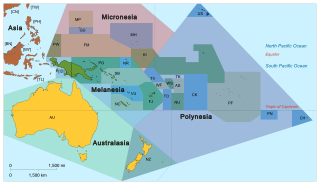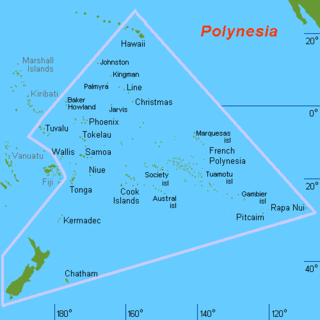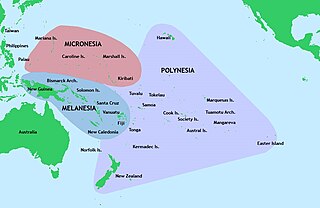
Micronesia is a subregion of Oceania, composed of thousands of small islands in the western Pacific Ocean. It has a close shared cultural history with two other island regions: Polynesia to the east and Island Melanesia to the south; as well as with the wider Austronesian peoples.

Hawaiian Paradise Park, also referred to as Paradise Park and known by many as HPP, is a census-designated place (CDP) in Hawaiʻi County, Hawaiʻi, United States, located in the District of Puna. The population was 11,404 at the 2010 census, up from 7,051 at the 2000 census.

Pacific Islanders, or Pasifika, are the peoples of the Pacific Islands. It is a geographic and ethnic/racial term to describe the inhabitants and diaspora of any of the three major sub-regions of Oceania: Micronesia, Melanesia, and Polynesia. These people speak various Austronesian languages. It is not used to describe non-native inhabitants of the Pacific islands.
Polynesia is a group of island chains spread across much of the Pacific Ocean, and includes many countries and territories. Internationally, Polynesian music is mostly associated with twinkling guitars, grass skirts and beautiful relaxing sounds, Hawaiian hula and other tourist-friendly forms of music. While these elements are justifiably a part of Polynesian history and Polynesian culture, there is actually a wide variety of music made in the far-flung reaches of Polynesia.
Polynesians are an ethnolinguistic group of closely related peoples who are native to Polynesia, an expansive region of Oceania in the Pacific Ocean. They trace their origins to Island Southeast Asia and are part of the larger Austronesian ethnolinguistic group with an Urheimat in Taiwan. They speak the Polynesian languages, a branch of the Oceanic subfamily of the Austronesian language family.

Territories of the United States are sub-national administrative divisions overseen by the United States government. The various U.S. territories differ from the U.S. states and Native American tribes in that they are not sovereign entities. They are classified by incorporation and whether they have an "organized" government through an organic act passed by Congress. All U.S. territories are part of the United States, but the unincorporated territories are not considered to be integral parts of the United States, and the Constitution of the United States applies only partially in those territories.
Fijians are a nation and ethnic group native to Fiji, who speak Fijian and share a common history and culture.

Polynesian culture is the culture of the indigenous peoples of Polynesia who share common traits in language, customs and society. Sequentially, the development of Polynesian culture can be divided into four different historical eras:
Samoan Americans are Americans of Samoan origin, including those who emigrated from the Independent State of Samoa or American Samoa to the United States. However they are not American Citizens. Samoan Americans are Pacific Islanders in the United States Census, and are the second largest Pacific Islander group in the U.S., after Native Hawaiians.
The indigenous peoples of Oceania are Polynesians, Melanesians, Micronesians, Papuans and Australian Aboriginals. With the notable exceptions of Australia, New Zealand, Hawaii, New Caledonia and Guam, indigenous peoples make up the majority of the populations of Oceania.
Race and ethnicity in the United States is a complex topic because the United States of America has a racially and ethnically diverse population. At the federal level, race and ethnicity have been categorized separately.
The Rotumans are the indigenous inhabitants of Rotuma, a small island group forming part of the Republic of Fiji. The island itself is a cultural melting pot at the crossroads of the Micronesian, Melanesian and Polynesian divisions of the Pacific Ocean, and due to the seafaring nature of traditional Pacific cultures, the indigenous Rotuman have adopted or share many aspects of its multifaceted culture with its Melanesian, Micronesian and Polynesian neighbours.
Micronesian Americans are Americans who are descended from people of the Federated States of Micronesia. According to the 2010 census, a total of 8,185 residents self-identified as having origins in the country, which consists of four states. More than half of these residents identified their origin as Chuuk State (4,211) with the rest as follows: 2,060 people from Pohnpei, 1,018 from Yap, and 906 people from Kosrae.

Polynesia is a subregion of Oceania, made up of more than 1,000 islands scattered over the central and southern Pacific Ocean. The indigenous people who inhabit the islands of Polynesia are termed Polynesians, sharing many similar traits including language family, culture and beliefs. Historically, they had a strong tradition of sailing and using stars to navigate at night. The largest country in Polynesia is New Zealand.

Asian-Pacific American (APA) or Asian-Pacific Islander (API) is a term sometimes used in the United States to include both Asian Americans and Pacific Islands Americans.
Tongan Americans are Americans who can trace their ancestry to Tonga, officially known as the Kingdom of Tonga. There are approximately 57,000 Tongans and Tongan Americans living in the United States, as of 2012. Tongans are considered to be Pacific Islanders in the United States Census, and are the fourth largest Pacific Islander American group in terms of population, after Native Hawaiians, Samoan Americans, and Guamanian/Chamorro Americans.

Relations between The Church of Jesus Christ of Latter-day Saints and the natives of the Pacific Island groups of Polynesia, Melanesia, Micronesia and surrounding island groups are quite complex.
Marshallese Americans are Americans of Marshallese descent or Marshallese people naturalized in the United States. According to the 2010 census, 22,434 people of Marshallese origin live in the United States. The United States has the highest concentration of Marshallese people outside the Marshall Islands. Most of these Marshallese people live in Hawaii and Arkansas.







